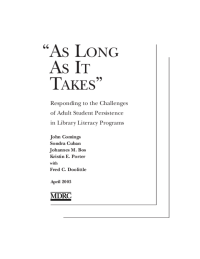"As Long As It Takes"
Responding to the Challenges of Adult Student Persistence in Library Literacy Programs
Research has shown that meaningful improvements in adult literacy require more than the annual average of about 70 hours that adult learners spend in organized literacy instruction. Low student persistence is therefore a critical issue for library literacy programs and other providers of adult education. In response, the Wallace–Reader’s Digest Funds launched the Literacy in Libraries Across America (LILAA) initiative in 1996. Of the fifteen participating libraries, five are the focus of the LILAA persistence study, which is being conducted by the Manpower Demonstration Research Corporation and the National Center for the Study of Adult Learning and Literacy. This interim report from the study examines the period, starting in 2000, during which the programs developed plans to improve student persistence and began to implement service enhancements.
The Adult Learners and Their Initial Patterns of Participation
- As the initiative began, literacy test scores averaged near the third-grade level on assessments of reading, phonetic decoding, and comprehension and at the fifth-grade level on a vocabulary test. Native English speakers had lower average scores than those who were learning English.
- Participation in program services fell short of the amount that research indicates is needed to improve literacy levels substantially. Only two-thirds of entrants remained in the program after three months, and entrants averaged 57 hours of participation over 18 months.
Early Implementation of Persistence Innovations
- LILAA’s continued focus on improving student persistence shaped program behavior and stimulated a search for ways to achieve this goal, which had more significance than many of the innovations originally planned.
- Most of the literacy programs focused on improving instruction and on changing operational procedures, such as expanding program hours.
- Support services (such as child care and transportation assistance) were the most difficult innovation for the library literacy programs to implement.
- People who entered the programs in 2001 participated for more hours during their period of active participation than did their counterparts in 2000. But the length of active participation did not differ between the two years.
Early Implementation Lessons
- Students expressed two types of learning goals: specific “instrumental” goals that must be reached in order to realize longer-term aspirations and broader “transformational” goals that entail major life changes, such as taking on a new social or work role. Literacy programs need to acknowledge and build on each type of goal to motivate long-term participation.
- Learners benefited from different types of sponsors — individuals who provided continuing encouragement and support. Library literacy programs could help students identify people who can play these roles, and they could support sponsors’ efforts.
- Learners see library literacy programs as caring and respectful and, hence, as different from other educational or social service organizations. Library literacy programs need to preserve this personalized atmosphere while simultaneously emphasizing more intensive participation.
A final report, scheduled for the fall of 2003, will discuss key factors supporting and inhibiting participation in adult literacy programs, changes that the sites made to support student persistence more effectively, changes in student persistence as these reforms took effect, innovations that appear to be especially promising, and the relationship between participation in library literacy services and improved literacy skills. The final report will also explore how library literacy programs fit within the broader adult education system.






